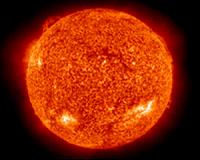 |
Melbourne FL (SPX) Dec 06, 2010 As Brevard County, FL, home to NASA's Kennedy Space Center, prepares for the end of the space shuttle program, the Aerospace Research and Engineering Systems Institute, Inc. is fostering the growth of high-technology research on the Space Coast through the establishment of a state-of-the-art plasma science and fusion research laboratory. Located near Kennedy Space Center, the Spacecoast Plasma and High-Energy Electrostatics Laboratory (SphereLab) will provide the opportunity for researchers from academia and industry as well as university students in Florida to engage in cutting-edge plasma and fusion research while also attracting talent from around the United States. The laboratory is intended to be a testbed for new technologies and potential commercial spinoffs from its research activities. SphereLab is envisioned as a state-of-the-art yet cost-effective facility for the study of high-energy plasma and the challenges and problems of nuclear fusion and its potential use in terrestrial and aerospace power and propulsion applications. "ARES Institute is currently involved in several projects, but SphereLab is really the cornerstone for our future activities," says Matthew Travis, Executive Director of the Aerospace Research and Engineering Systems Institute. "The concept has been in development for several years. "We hope to attract and retain high-technology talent in the area after the shuttle program ends. More than that, we want to see Central Florida become known as the foremost location for fusion-related science and technology research in the same way that Silicon Valley is synonymous with computer technology." Currently, work on the laboratory is focused on designing the first of its central instruments, a Hirsch-Meeks Inertial Electrostatic Confinement fusor (a type of fusion reactor) suitable for initial research activities, along with fundraising for the acquisition and construction of the laboratory facility itself. Additionally, ARES Institute has identified several potential grant opportunities with the National Science Foundation and Air Force Research Laboratory that it intends to pursue. Once the laboratory is operational, it will be available for university students and researchers to use to conduct their own experiments. An overriding goal is to draw scientists and researchers together at a facility with unique capabilities not found elsewhere in Florida. Currently, the development timetable is targeting Spring of 2011 for occupation of temporary facilities and startup of the first fusor instrument. The laboratory will be fully outfitted by the end of 2011. Eventually, the laboratory will move into a permanent home, perhaps at KSC's Exploration Park. For more information, please visit http://www.aresinstitute.org/spherelab. For more information about ARES Institute and its programs, visit our website at http://www.aresinstitute.org.
Research Specifics In giving a university or private sector partner a piece of equipment able to draw prestigious investigators to use it, this program will also attract graduate and doctoral students of the highest caliber to work with them. The laboratory will place emphasis on investigations into the potential aerospace applications of IEC fusion. Along the way, it will help advance the goal of achieving Earth-based fusion power production and the holy grail of producing more power from the reaction than is required to sustain it. Additionally, SphereLab will undertake difficult, high-risk/high-reward investigations in a variety of disciplines, the relative activity and prominence of each dependent upon the degree of external funding that can be developed in that program area. Targets for study include High Performance Aerospace Power and Propulsion; Controlled Nuclear Fusion and Alternative Energy; Pollution Control, Waste Remediation and Resource Recovery; Mineral Refining, Materials Science and Industrial Processing; Next Generation Radiofrequency Antenna Architectures; and Advanced Laser/Maser Systems Development.
Share This Article With Planet Earth
Related Links ARES Institute Powering The World in the 21st Century at Energy-Daily.com
 Getting To Know The Sun Advances Fusion Research
Getting To Know The Sun Advances Fusion ResearchPrinceton NJ (SPX) Nov 09, 2010 Researchers at the Princeton Plasma Physics Laboratory have successfully used Coaxial Helicity Injection (CHI) to generate plasma current and couple it to a conventional current generation method at the National Spherical Torus Experiment (NSTX) fusion experiment. After coupling, the combined process generated 1 million amperes of current using 40 percent less energy than needed to generat ... read more |
|
| The content herein, unless otherwise known to be public domain, are Copyright 1995-2010 - SpaceDaily. AFP and UPI Wire Stories are copyright Agence France-Presse and United Press International. ESA Portal Reports are copyright European Space Agency. All NASA sourced material is public domain. Additional copyrights may apply in whole or part to other bona fide parties. Advertising does not imply endorsement,agreement or approval of any opinions, statements or information provided by SpaceDaily on any Web page published or hosted by SpaceDaily. Privacy Statement |